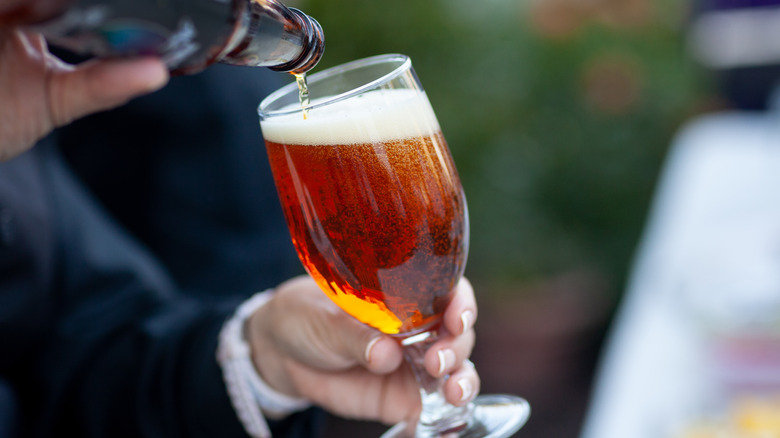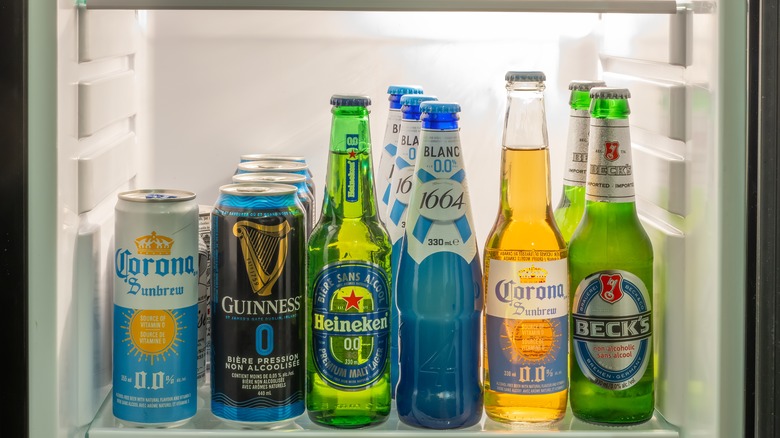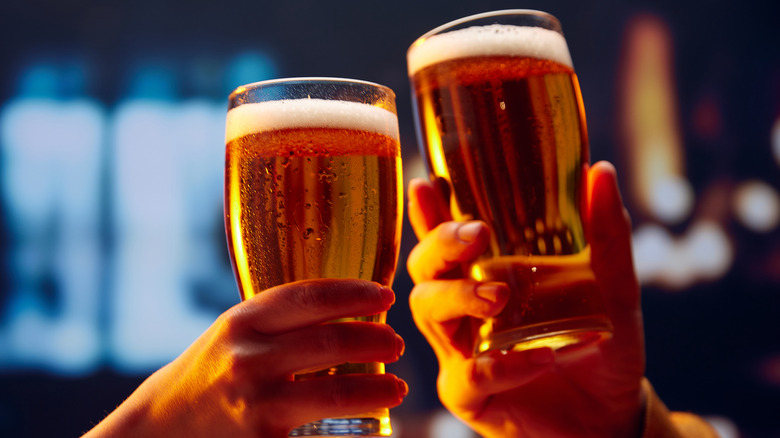Here's How Many Non-Alcoholic Beers Equal A Regular Brew
Recent years have seen a huge increase in the availability of non-alcoholic beers. Not only are they easier to find now, but there's also a decent range and the overall quality has significantly improved. However, whatever your reason for choosing a non-alcoholic drink, it's good to have some idea how they stack up against their alcoholic counterparts.
It's not possible to give a single answer on how many non-alcoholic beers would equal a single alcoholic beer — simply because the amount of alcohol in different beers varies so wildly. That being said, the National Institute on Alcohol and Alcoholism Abuse defines a "regular beer" as having 5% alcohol content. So, while some will have much more alcohol (or a little less), 5% is a good average to assume.
The amount of alcohol that is in a non-alcoholic beer, while very small, still varies. Legally, anything between 0.0% and 0.5% can be labeled as "non-alcoholic" (as opposed to "alcohol-free"). Taking the upper end of that and some simple math, drinking 10 non-alcoholic beers could be equitable to drinking a single alcoholic beer.
Is there any risk of getting drunk on non-alcoholic beer?
The short answer to whether you can get drunk on non-alcoholic beer is "no." It's hard to define at what point someone becomes "drunk;" everybody metabolizes alcohol at different rates, and the effects of that alcohol will vary from person to person. In the United States, the legal limit for driving is a blood alcohol level of 0.08%, which is figured to be about four or five drinks in a relatively short space of time.
To be drunk enough to hit the legal driving limit in the United States, you'd have to be drinking at least forty to fifty non-alcoholic beers of around 0.5% in the space of a few hours. To even get slightly inebriated, you'd have to be downing the non-alcoholic beers uncomfortably fast. There's really no risk of getting even a little tipsy on non-alcoholic beer, so you're safe to relax with a few and not stress about it (however, if you're in recovery, it still might not be the best idea for other reasons).
How much alcohol is really in non-alcoholic beer
Of course, all of that assumes that non-alcoholic beer has 0.5% alcohol in it. When defining the amount of alcohol that could be present in non-alcoholic beer, that low level was set to account for the fact that getting all the way to 0% wasn't really feasible. However, most non-alcoholic beers these days have significantly less than 0.5%.
Some brands list themselves as being 0% entirely, but it's more common to see amounts around 0.05%. That means that the most common alcohol percentage for non-alcoholic beers comes in at just one-tenth of the 0.5% amount that can legally be in a non-alcoholic beer (the quantity that we used for our earlier calculations). So, in practice, rather than ten non-alcoholic beers being equal to the alcohol in one alcoholic beer, you'd actually need to drink one hundred non-alcoholic beers to consume the same amount as one alcoholic beer. There are a lot of things that you might need to worry about if you drank 100 non-alcoholic beers in an evening, but getting drunk would be pretty far down the list.


